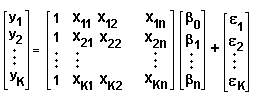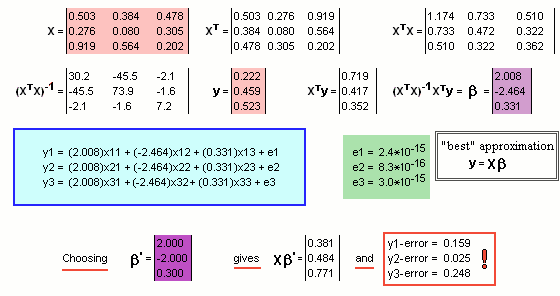Linear Regression
This tutorial written and reproduced with permission from Peter Ponzo
We assume that some set of variables, y1, y2, … yK, is dependent upon variables xk1, xk2, … xkn (for k = 1 to K). We assume the relationship betwen the ys and xs is “almost” linear, like so:
[1]
y1 = ß0 + ß1x11 + ß2x12 + … +ßnx1n + e1
y2 = ß0 + ß1x21 + ß2x22 + … +ßnx2n + e2
……..
yK = ß0 + ß1xK1 + ß2xK2 + … +ßnxKn + eK
Why so many variables?
Well, suppose we note that, when the xs have the values x11, x12, … x1n, the y-value is y1. We suspect an almost linear relationship, so we try again, noting that x-values x21, x22, … x2n result in a y-value of y2. We continue, for K observations, where, for x-values xK1, xK2, … xKn the result is a y-value of yK. Then in an attempt to identify the “almost” linear relationship, we assume the relationship [1].
We can write this in matrix format, like so:
[2]

or, more elegantly:
[3]
y = Xß + e
where y, ß and e are column vectors and X is a K x (n+1) matrix.
We attempt to minimize the sum of the squares of the errors (also called “residuals”) by clever choice of the parameters ß0, ß1, … ßn.
E = e12 + e22 + …+eK2 = eTe where the row vector eT denotes the transpose of e.
(Note that this sum of squares is just the square of the magnitude of the vector e … so we’re making the vector as small as possible.) We set all the derivatives to zero, to locate the minimum.
For each j = 0 to n we have:
?E / ?ßj = 2 e1 ?e1/?ßj + 2 e2 ?e2/?ßj + … + 2 eK ?eK/?ßJ = 2 S ek ?ek/?ßj = 0
the summation being from k = 1 to K.
Since ek = yk – ß0 – ß1xk1 – ß2xk2 – … – ßnxkn (from [1]) then:
ek ?ek/?ßj = [yk – ß0 – ß1xk1 – ß2xk2 – … – ßnxkn] (-xkj) = -(xkj)* [yk – ß1xk1 – ß2xk2 – … – ßnxkn]
= -(the kjth component of X)*[the kth component of y – Xß]
= -(the jkth component of XT)*[the kth component of y – Xß]
then we have n+1 equations (for j = 0 to n) like:
[4]
Sek ?ek/?ßj = – S(the jkth component of XT)*[the kth component of y – Xß] … summed over k.
But [4] defines the jth component of the n-component column vector: XT [ y – Xß ]. Setting them to zero gives us n+1 such linear equations to solve for the n+1 parameters ß0, ß1, ß2 … ßn, namely:
[5] XT [ y – Xß ] = 0.
What about the xs and ys?
We know them. They’re our observations and our goal is to determine the “almost” linear relationship between them. That means finding the (n+1) ß-values which we do by solving [5] for:
[6] ß = (XTX)-1XTy where (XTX)-1 denotes the inverse of XTX.
Don’t you find that … uh, a little confusing?
It’ll look better if we elevate it’s position like so:
If we wish to find the “best” linear relationship between the values of y1, y2, … yK and xk1, xk2, … xkn (for k = 1 to K) according to:
y1 = ß0 + ß1x11 + ß2x12 + … +ßnx1n + e1
y2 = ß0 + ß1x21 + ß2x22 + … +ßnx2n + e2
……..
yK = ß0 + ß1xK1 + ß2xK2 + … +ßnxKn + eK
or

or
y = Xß + e
where the K-vector e denotes the errors (or residuals) in the linear approximation, y is a K-vector, ß an (n+1)-vector and X a K x (n+1) matrix, then we can minimize the size of the residuals by selecting the ß-values according to: ß = (XTX)-1XTy
Well it doesn’t look better to me!
Here’s an example where K = n = 3 and ß0 = 0 (so we’re looking for ß1, ß2 and ß3 and we ignore that first column of 1s in X):

Note the assumed values for the X matrix and the column vector y … coloured ![]()
We run thru’ the ritual, calculating XT and XTX etc. etc. … and finally the ß parameters … coloured ![]()
The resultant (almost linear) relationship is inside the blue box.
There are (as expected!), errors denoted by e1, e2 and e3 … but they’re pretty small. They’re coloured ![]()
If, instead of those “best” choices for the parameters, we had chosen a different set, say ß’ coloured ![]() the errors are significantly greater.
the errors are significantly greater.
